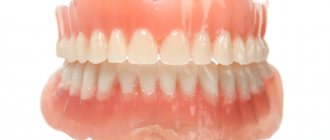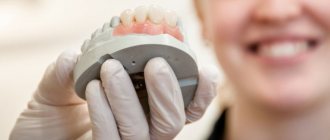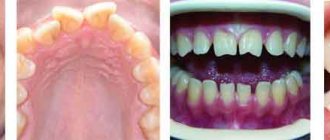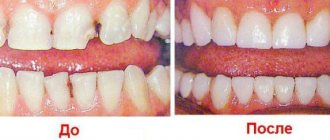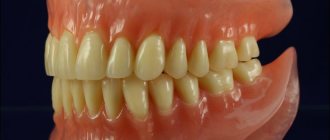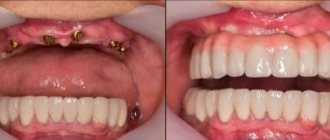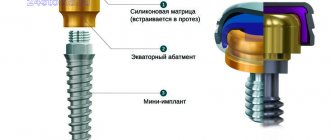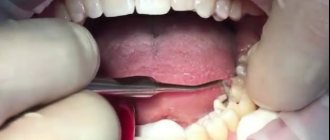Restoring the integrity of the elements of the dentition involves a whole range of measures. If the attending dentist has decided to install a prosthesis using abutment teeth, they will have to be carefully processed first. It should be understood that grinding is a process of injury to bone tissue, which is accompanied by the removal of the pulp (the so-called dental nerve), even if the tooth is healthy. This is undesirable unless absolutely necessary, since a “dead” tooth becomes more fragile and breaks down faster. Fortunately, modern dentistry offers alternative methods of dental prosthetics - without grinding.
“These are modern, gentle techniques that allow you to preserve the health of your teeth, avoiding their depulpation and mechanical treatment. With their help, you can restore the normal functioning of the jaw, as well as achieve high aesthetic values.”
Seregin Sergey Sergeevich, dentist-implantologist at the 32 Dent clinic
Adhesive prosthetics without turning
This is a relatively new technology for prosthetics, usually of one tooth without grinding the adjacent ones. Its other name is adhesive bridge prosthetics, AMP (Maryland or Manhattan bridge). This is only possible if there are no extensive carious cavities in the teeth located next to the causative one.
A simplified creation of an AMP looks like this:
- Small notches (grooves) are created on the chewing surface of the supporting teeth (and if the front teeth, then on the back surface). These grooves are formed within the enamel and do not destroy its internal tissue - dentin.
- The required length of the reinforcing tape (the one on which the artificial tooth will subsequently be attached) is measured and impregnated with a special adhesive composition made of a fluid composite material. The tape itself is made of translucent fiberglass, which in its overall combination gives it strength that is not inferior to that of metal. By the way, this is exactly how the well-known body armor is produced.
- This tape is placed in the formed cavities of the teeth, and thus a beam is formed: the tape is given the correct shape, and then it is polymerized with light.
- Next, taking into account the color and shape, an artificial hinged tooth is modeled.
- It is fixed to the formed structure.
Advantages of the method:
- it is gentle: crowns are created almost without grinding, in contrast to the traditional preparation method;
- it has a low cost;
- a possible allergic reaction to metal is excluded;
- the structure created in this way is very durable;
- it is reversible: you can always change your mind and choose an alternative treatment method.
Disadvantages of the method:
- the fragility of the structure; over time, the adhesive prosthesis requires replacement.
Implantation
In terms of efficiency, aesthetics and functionality, no method of treating partial edentia can be compared with implantation. When using this method of prosthetics without turning, not only the visible part of the tooth is restored, but also the root is modeled. Its function is performed by a titanium implant implanted into the jaw. A crown is installed on top of it in a special way.
Advantages of implantation over other methods of prosthetics without turning:
- Safety. Healthy teeth are not affected at all.
- High functionality. The created system imitates a natural tooth, that is, it also loads the jaw and prevents its resorption (resorption).
- Impeccable aesthetics. Crowns on implants look attractive and are difficult to distinguish from natural teeth.
- Durability. Such structures can last 10-15 years or more.
Free consultation
30-40 minutes
inspection and diagnostics
treatment plan and cost
Make an appointment
Prosthetics with micro-locks (CBW system)
This method is somewhat similar to the previous one. A bridge is created without turning or a beam structure, but with the help of a system of locks on which the denture will be attached.
Prosthetics process:
- A crown is created for the patient in advance. At his request, it can be made of any material.
- Small holes—microchannels—are drilled on the surfaces of adjacent teeth. These holes affect not only the enamel, but also the dentin. Their size and depth of penetration are so small that it does not affect the appearance of the teeth. The penetration depth of boron is regulated by a special limiter.
- Micro-locks are inserted into the resulting holes. They are so miniature that three of these locks can fit on the smallest pinhead.
- The resulting structure is secured with reflective composite material.
- Then an artificial tooth is inserted, on the side surfaces of which there are the second parts of micro-locks. Their location is congruent (completely coincides) with those located on the supporting teeth.
- The installed micro-locks are activated, and the coupling area is again covered with a composite and polymerized with light rays.
Advantages of the method:
- He is gentle. The bridge is created without turning the adjacent ones, which inevitably leads to their depulpation and, accordingly, destruction.
- Such prosthetics are very durable: the structure can withstand loads exceeding the maximum possible chewing pressure due to its even distribution between the supporting teeth.
- Hi's fast.
- There is always the option to choose a different type of treatment. The crown is easily removed, the micro-locks are removed, and the small tubules are filled.
Flaws:
- Many dentists doubt the durability of this method of prosthetics and advise using it as a temporary stage of treatment.
Bridge without turning
Prosthetics with micro-locks is a relatively new type of restoration of a lost tooth. The method is quite simple: microchannels are created in the walls of the supporting teeth, in which locks are fixed that hold the intermediate part of the bridge. The supporting teeth are not ground down or depulped (nerves are not removed). Due to the design features, bridges with micro-locks can withstand loads that far exceed the maximum possible value of chewing pressure, and the locks optimally distribute the load between the supports, eliminating pressure on the gums. However, the reliability of the system is quite questionable, and is recommended by leading dentists as a temporary structure, for example, during the healing period of an installed implant in the smile area.
Prosthetics with flexible nylon prostheses
If in the two previous methods it was possible to restore only one tooth, then the use of nylon dentures allows you to recreate several consecutive teeth, and in some cases, the entire dentition of the upper or lower jaws. This manufacturing option is comparable to conditionally removable or even complete removable prosthetics.
Nylon is light, thin and extremely flexible. It is used in construction as a frame (base) on which one or more artificial teeth are attached. It is due to the special properties of nylon that the prosthesis tightly grips the gums and supporting teeth, while at the same time very softly adhering to one of the palates.
Manufacturing:
- As usual, silicone impressions are first made of the problem area of the oral cavity and the surrounding mucous membrane.
- Then, using a special apparatus, the frame of the future prosthesis is cast over them under very high pressure.
- The required number of dental crowns are attached to the resulting base.
Advantages of the method:
- Allows you not to feel the prosthesis in your mouth. The old type of removable dentures put pressure on the gums, so most patients treated them very poorly. But nylon structures are not felt in the mouth after about a week of using them.
- An allergic reaction is excluded, because the prosthesis does not contain any metal ions, but monomers.
- The structure is securely and firmly attached. If it is a complete removable denture, then it is attached without the use of additional adhesive materials; if it is partially removable, then nylon clasps are used for fixation, which are secured to the supporting teeth.
- Nylon does not absorb other substances, including dyes, and remains translucent throughout its service life.
- Dentures do not require special care.
Disadvantages of the method:
- The pattern of the mucous membrane of a person’s mouth changes over time, and the prosthesis in areas of contact with it will begin to rub the tissue of the mucous membrane. In this case, adjustments to the entire structure are required.
- They wear out quite quickly. Their service life is two to three years.
- High price. The price of such a prosthesis is approximately twice as high as the cost of a rigid plate prosthesis made of acrylic.
Indications and contraindications
Prosthetics are performed on patients if:
- they have partial loss of teeth,
- it is impossible to install permanent bridge structures,
- there are contraindications for implantation,
- teeth became loose due to the development of periodontal disease (inflammation of the periodontal tissues).
Prosthetics cannot be performed if the patient:
- no supporting teeth
- low support units,
- deep bite,
- shallow floor of the mouth,
- allergy to metals,
- less than 6 units left in the dentition,
- acute inflammatory processes in the oral cavity.
The last point is a temporary contraindication. After eliminating the inflammatory process, you can begin prosthetics.
Prosthetics using inlays
When a tooth is very badly damaged and it is impossible to create a filling that would exactly replicate its previous shape, they resort to prosthetics using the inlay method. Previously, such a tooth inevitably had to be ground down in order to cover it with a crown, but now, thanks to inlays, the destroyed fragment of the tooth is completed without destroying it even more.
An impression is taken of the damaged tooth and its adjacent supporting teeth, from which an inlay of the desired shape will be created in the laboratory. It is created from a composite material or ceramic and will be shaped like a regular filling. Then such an inlay is cemented.
Types of clasp dentures
These designs differ from each other by a metal frame. It can be one-piece, cast on fire-resistant models, or composite, in which all metal elements are soldered together. Such dentures are one-sided, which restore the dentition on one side, and bilateral, they are used to restore the dentition on both sides of the jaw.
The designs differ in the fixation system, there are three in total:
- fastening with clasps,
- fastening on attachments,
- fixation using telescopic crowns.
The main task of clasp prosthetics is to restore the speech and chewing functionality of the dentition. However, there are structures that perform an additional function - they serve as support for loose teeth. These are splinting prostheses. They contain a thin metal arch that follows the shape of the dentition and is located on the inside of it. The arch supports problematic teeth in the desired position and stabilizes them. Splinting dentures are used for periodontitis and periodontal disease. Properly selected structures significantly extend the life of loose teeth.
Technology Feature
Prosthetics of one tooth without grinding adjacent teeth is used to restore anterior and chewing teeth. The main advantages of the technology include:
- bone tissue is not deprived of nutrition and is able to function throughout life;
- quick installation;
- preservation of the upper part and neurovascular bundle of nearby healthy teeth;
- no injury;
- the period of recovery and adaptation is minimal;
- installation is possible even on sealed units;
- affordable price;
- aesthetics.
A new method of prosthetics involves installing a matrix lock, which serves as the basis for the prosthesis. To install the product, a channel 1.7 mm long and 1.3 mm in diameter is drilled in the side of the tooth, after which a matrix lock is inserted and fixed to cement.
During the manufacture of the product, a matrix is inserted into the side surface, when the connection occurs, the lock snaps into place. The design allows you to evenly distribute pressure when loading the jaw, so that the prosthesis functions completely naturally.
Patient reviews
Hello. I had nylon dentures done, although they say that the service life of such dentures is a maximum of 3 years, I have been wearing them for 5 years already. The product really fits perfectly; over the years I have never seen any flaws.
Marina, Nizhny Novgorod
I had implantation done, it was very painful, and my recovery period was six months.
Dmitry, Ivanovo.
Hello.
Three years ago I had an inlay made; it fell off within a year. A waste of time and money. Having contacted the dentist, we came to the conclusion that we would remove the tooth and do adhesive prosthetics. Svetlana. Novokuznetsk.
